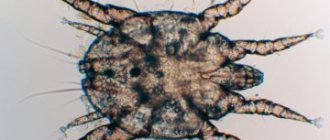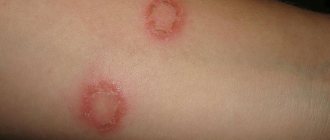Ear mites or otodectosis are a fairly common disease not only among stray cats, but also widespread among pets. And the manifestation of this disease should not be taken lightly. The consequences of neglected painful damage to the cat's body by ticks can be very serious.
Every cat owner should have a clear understanding of the disease picture and know what to do if a tick is detected on their pet. You should also know what an ear mite looks like.
Getting rid of ear parasites can sometimes be quite difficult, so timely treatment and preventive measures are the key to the health of your beloved cat.
Where does it come from - the causes of occurrence
The question “where do ear mites come from in cats” most often worries pet owners, who sometimes never even go outside. The causes of otodectosis can be not only direct contact with stray animals, but also indirect routes of transmission of the disease.
It is known that a cat can acquire this parasite by sharing care items with an infected animal. Ticks are transmitted through a towel or comb.
The leading position as a source of infection is still occupied by homeless animals. They account for about 80 percent of the total number of cases of infection. The anatomical structure of the cat's auricle serves as an additional risk factor for the occurrence of this disease. The cat's owner can also become a carrier of ear mites on clothes, shoes, and even hands. In a kitten, ear mites can occur as a result of infection from the mother.
Ear mites in cats: signs and symptoms
You can see what the picture of ear mite disease looks like in the photo. Click to enlarge.
The highest percentage of mite infestation occurs in kittens aged 1 to 6 months and in older or weakened cats.
How can you tell if your pet is suffering from ear mites? There are a number of signs indicating the presence of this arthropod parasite.
The main symptoms of the disease are as follows:
- The animal shakes its head frequently, and a rattling sound may be heard.
- Black wax builds up in the ears, which can lead to stone-like plugs.
- When a cat shakes its head, liquid droplets may spray from the ears.
- Bleeding scratches form in and around the auricle.
- As a result of pus draining from the ears, the hair around the ear may become sticky.
- High body temperature.
- Nervous attacks.
- The cat's constant desire to scratch the affected ear.
- Nervous, restless behavior, sometimes even aggression on the part of the cat.
- Unpleasant odor from the ears.
The listed signs may be complemented by an atypical tilt of the head with the affected ear drooping down. If you have such symptoms, you should consult a doctor to decide how to treat your pet.
Causes of ear mites
Most of the confusion arises among owners of domestic cats who do not go out for walks at all. But there are a large number of reasons for the appearance of such a disease:
- the most common option is direct contact of a pet with an infected animal;
- using the same combs, bowls, toys and other items for healthy and sick animals;
- fleas can carry ticks;
- Ticks enter the house on a person. He brings them on shoes, clothes or hands;
- ear mites can be carried by flies.
How to tell if your cat has ear mites
To effectively combat ear mites, it is necessary to properly diagnose them. This can be done at home. To understand that your cat is really infected, you need to know the main symptoms that accompany this disease:
- itching in the ears. The cat begins to scratch behind the ears, rub against corners and other sharp objects;
- the animal becomes restless and clings to the person. Often infected pets shake their heads, trying to get rid of what is bothering them so much;
- a large amount of sulfur and purulent mass appear in the ears;
- brown crusts and severe redness of the skin appear around the ears;
- waste products of parasites contribute to the appearance of an unpleasant odor;
- the advanced form of the disease is accompanied by the appearance of skin scales, bleeding wounds, and purulent discharge.
Why are ear mites dangerous in cats?
The consequence of advanced ear mite infection in cats can be the development of a serious inflammatory process, which subsequently leads to rupture of the eardrum and hearing loss.
In severe cases, the tick may penetrate the inner ear and damage the lining of the brain. Evidence of an advanced process is systematic seizures that are similar to epileptic ones. This symptomatology can lead to death and the inevitable death of the pet.
Symptoms of ear mite infestation in cats
The cause of otodectosis is a mite, the size of which ranges from 0.2 to 0.5 mm, which settles in the ear canal of cats and dogs. The parasite feeds on exfoliated skin cells. The waste products released in this process irritate the inner surface of the ear, disrupt the normal microflora, cause itching and an inflammatory reaction.
Important! In the absence of therapy, a large amount of purulent exudate accumulates in the ear cavity, causing the melting of the eardrum and the spread of inflammation to the membranes of the brain. In this case, death is inevitable.
The first alarming symptom of otodectosis is severe itching. The cat unnaturally tilts its head towards the affected ear, constantly scratches it, and rubs against surrounding objects. As a result, scratches appear on the surface of the ears, in which pyogenic bacteria quickly develop.
Other signs of the disease include:
- an increase in local temperature in the affected area, gradually turning into a general fever;
- the appearance on the inside of the ear and in the ear canal of a dark brown coating that has an unpleasant odor and the consistency of which resembles fuel oil;
- when complicated by a secondary infection, brown exudate begins to flow from the auricle, which, when dried, clogs the ear canal and causes hair to stick together.
If you do not remove purulent discharge, then in the future they irritate the skin, lead to inflammation, hair loss, and the formation of weeping wounds and ulcers.
Are ear mites dangerous for humans?
The question of whether ear mites can be transmitted to humans and whether they can be contracted from pets has an ambiguous answer. The risk of otodectosis for humans is a small percentage.
It has been scientifically proven that the dangerous disease is not transmitted to humans. Still, some experts recommend caution when interacting with a sick pet. It is possible that otitis may develop in people with weakened immune systems when caring for an infected animal without following safety precautions.
Treatment of ear mites in cats
Ridding your pet of ear mites at the onset of the disease will not be difficult. If you notice symptoms indicating a possible infection in your pet, you should immediately consult a doctor. You cannot diagnose or treat your pet on your own! Why?! Because this can aggravate the situation and waste time, and in the meantime the disease can move to the next stage.
Only a doctor determines how to treat otodectosis, taking into account the stage of the disease, the age of the animal, its state of health, and the presence of pregnancy in cats.
With the help of special medications, ear diseases are treated with great success. A prerequisite before treating the ears is to clean them.
This should be done as follows:
- A cotton pad or cotton swab is moistened in one of the products - chlorhexidine or 2% hydrogen peroxide solution, or camphor alcohol
- Cleaning the ears
- Then apply the amount of ointment specified by the doctor or instill the required number of drops.
- The auricle is gently massaged at the base to distribute the product evenly.
It is worth remembering that parasites can live on a cat's body, so antiparasitic drugs should be used on the entire surface of the body. During the treatment period, it is necessary to provide the cat with a varied fortified diet and access to fresh air. To kill ticks indoors, you should clean with acaricidal agents.
Folk remedies
Before giving preference to folk remedies, you should understand that they are not always effective and can cure odecosis.
They can be useful and actually bring a positive result only in cases where the infection is detected at the initial stage and the animal has strong immunity. Sulfur ointment, boric acid and camphor oil are used as folk remedies.
Sulfuric ointment
The advantage of this product is the ability to relieve your pet from itching; he will not scratch his ears, which means there will be no wounds into which additional infection and bacteria can get.
In addition, the ointment helps reduce tissue swelling and reduce the inflammatory process. It should be remembered that the use of ointment leads to severe drying of the skin, so it is necessary to periodically moisten the skin with antiseptic agents.
Boric acid
In this case, a 3% boric acid solution is used. It has a direct effect on parasites. Before use, it is necessary to clean the sink from accumulated plaque; for this, use a cotton pad soaked in an antiseptic.
Camphor oil
This is an indispensable tool for clearing scabs and crusts from your ears. It does not have an antiparasitic effect. Before using the oil, it is recommended to warm it up a little.
Medicines
To treat ear mites, medications are used in the form of sprays, powders, ointments, solutions, as well as injections.
At the initial stage, the following is prescribed:
- "Amit"
- "Acromectin"
- "Amitrazine"
- "Tactician"
Special preparations in the form of sprays, such as Tsiodrin, Acrodex, Dermatosol, can simply be sprayed on the area of the affected ear, approximately at a distance of 5 -5.5 cm from it.
To reduce the appearance of itching and relieve inflammation, Otonazole drops are prescribed. Ointments with sulfur compounds can be called effective - Sulfur ointment, Vishnevsky ointment.”
In advanced stages of the disease, Otodectin is used.
Anti-inflammatory ointments
When otodectosis is complicated by bacterial and fungal microflora, as well as to eliminate inflammation, ointments “Lorinden S”, “Iruksovetin”, “Levomekol” and their analogues are prescribed.
The preparations are applied to the cleaned inner surface of the auricle and distributed evenly over it using massage.
In addition to the antiseptic effect, ointments accelerate the healing process, relieve itching and pain.
Recently, veterinary specialists often prescribe the combined drug Amidel-gel NEO, which is a mixture of an acaricide, an antibiotic and an anesthetic. It is applied to the affected area of the ear canal once every 7 days. The course of treatment is from 3 to 5 weeks, depending on the intensity of infection.
Folk remedies for ear mites in cats
Folk remedies are used purely at the initial stage.
The following folk remedies for ear mites in cats are successfully used at home
- Brewing green tea. Place in ears several times a day.
- Infuse a mixture of ½ clove of garlic and 2 tablespoons of almond oil for 24 hours, and after straining through gauze, lubricate the ears with it once a day. Reviews from owners indicate the effectiveness of using pure almond oil, without adding garlic.
Anti-tick medications:
- Drops . This is the most popular product, which today is presented in a large assortment. The most popular of them are “Bars”, “Amit”, “Amitrazine”. The effectiveness of drops depends not only on their quality. This is influenced by many factors: the degree of infection, adherence to dosage, individual tolerance of the active ingredients. There are drops intended for prevention, as well as products recommended for severe infections. You can choose drops for small kittens.
- Treatment with folk remedies . If it is not possible to purchase special medications, traditional methods of treatment will help. There are known methods that have received positive reviews:
- Garlic is infused in sunflower, almond or olive oil. Once a day, the resulting tincture is instilled, two drops into each ear.
- Celandine juice is obtained by grinding the plant in a meat grinder. Place two drops in each ear twice a day.
- A solution of iodine and glycerin in a ratio of 1:4 is used to treat the affected areas.
- Treatment with peroxide . It is incorrect to think that hydrogen peroxide can get rid of ear mites. After all, this is not a medicine. But it is still recommended to use this product for rinsing. So, after rinsing your ears with peroxide, you can begin treatment with drops or other drugs from a veterinary pharmacy.
- Insecticidal preparations . These can be drops on the withers or sprays intended to treat the animal’s body. They are used in the treatment of ear mites, when the parasite leaves the ears and moves to the head or body. You can also spray bedding and other favorite places for pets. By combining these drugs with other treatments, you can achieve the desired effect.
How long does it take to treat ear mites in cats?
A cat affected by ear mites can be quickly cured only if the disease is detected in the early stages. If the process is neglected, you will have to fight for a long time. It will be necessary to carry out a full course of treatment, which can last from 7 to 10 days. The treatment process, in order to completely remove ticks, cannot be stopped before the specified period.
After a successful course of treatment, the black contents in the ears disappear. In this case, the black plaque changes its color to brown.
Disease prevention
Preventive measures will protect or detect the disease at an early stage. To avoid infection, try to limit your cat's contact with stray animals. You should also check your pet's ears regularly. To reduce the likelihood of infection, constant hygiene is necessary. Using moistened cotton swabs, periodically clean the ears.
Veterinarians recommend monthly use of hygiene lotions designed to treat the ear canals. They have a low price, but are an effective preventive measure. Such products are suitable for pregnant females, kittens and cats with weakened immune systems.
Healthy cats are not at risk. Of course, they can become infected, but this happens much less frequently than in sick animals. That is why it is necessary to regularly monitor the general health of the animal. Provide your pet with proper and balanced nutrition, which will have a positive effect on the condition of the whole body.
At the same time, you need to understand that any preventive measures do not provide a 100% guarantee of protection against infection. The combination of all these methods will only minimize the likelihood of infection with ear mites.
Preventing ear mites in cats
Prevention of ear mite infection involves eliminating contact between your pet and street animals. Ear mites in a cat can result from other factors. It is necessary to examine the cat every time after a visit to the clinic, mating in someone else's house, or a walk on the street. You should avoid using items from other animals and carefully monitor your pet’s hygiene and health. The cat should not be allowed to rub against outdoor shoes or clothing. It is necessary to carry out mandatory wet cleaning in the house with special anti-tick products.
Veterinarian advice
Veterinarians specializing in the treatment and prevention of feline ear diseases recommend that cat owners use special flea and tick collars to protect their pets. After an illness, re-infection may occur, since immunity to this parasite is not developed.
Video with veterinarian advice:
By paying close attention to the problem of ear mite infestation, you can achieve a positive result and save your animal from a serious illness. Timely and high-quality treatment will return your pet to health and leave no chance for ticks.
Stages of disease development
As mentioned earlier, otodectosis occurs quite often in pets. If you look at the statistics, ear mite infection is diagnosed in 85% of all calls. It is also called ear scabies.
This disease is caused by the mite Otodectes cynotis, which parasitizes the upper layer of the epidermis. The mite is localized in the auricle and ear canal.
The disease goes through several stages of development:
- At the first stage, mechanical damage occurs to the upper layers of the skin. Individuals have a fairly strong oral apparatus, with which they gnaw through the skin. They make their way under the skin, where they gnaw holes for themselves. During parasitism, individuals release waste products that are toxic to the animal. At this stage, the skin is injured, both by the parasite and by the animals themselves, as the cats begin to scratch their ears from the unbearable itching.
- Tick parasitism leads to depletion of the walls of blood vessels, due to the accumulation of blood, redness and swelling appear.
- Discharge appears on the skin.
- Waste products, dead epidermal cells and secretions mix, leading to the formation of scabs. The scabs are dark brown in color. In addition, putrefactive microflora develops.
- Scabs accumulate in the ear canal, resulting in plugs that cause dullness of hearing.
- If there is no treatment, inflammation of the eardrum develops, which leads to its rupture. In such cases, infection of the middle and inner ear occurs.
- When inflammation of the inner ear occurs, the pathology affects the entire hearing system. Pets at this stage are more likely to keep their head turned and their ears pointing down.
- Severe stages of the disease lead to damage to the lining of the brain, which causes sepsis and the animal dies.
The disease has dangerous and serious consequences and proper treatment is required.











